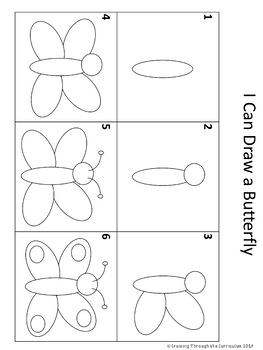Directed Drawing Butterfly
Have you ever tried directed drawing butterfly with your kids or students? It's an excellent way to combine creativity and learning. Not only does it improve fine motor skills, but it can also boost confidence and encourage critical thinking. In this blog post, we will explore the benefits of directed drawing butterfly and how it can be a valuable tool for kids of all ages.
The Pain Points of Directed Drawing Butterfly
While directed drawing butterfly can be a fun and enriching activity, some kids may find it challenging to follow along with the steps. Younger children may struggle with fine motor skills, making it difficult to create the necessary shapes and lines. Additionally, some kids may feel discouraged if their final product doesn't match the example, leading to feelings of frustration and disappointment. However, with proper guidance and support, these pain points can be overcome.
The Target of Directed Drawing Butterfly
The target of directed drawing butterfly is to teach kids how to break down and simplify complex shapes into smaller, more manageable pieces. By following along with step-by-step instructions, children can learn new vocabulary words and concepts while improving their fine motor skills. They can also develop confidence in their ability to create something beautiful and unique.
Summarizing the Benefits of Directed Drawing Butterfly
Overall, directed drawing butterfly offers numerous benefits for kids, including:
- Improving fine motor skills
- Encouraging creativity
- Boosting confidence
- Teaching new vocabulary words and concepts
- Developing critical thinking skills
My Personal Experience with Directed Drawing Butterfly
When I first introduced directed drawing butterfly to my students, some were unsure if they could follow the steps. However, as we worked together, they began to gain confidence in their ability to create something beautiful. I was impressed by how engaged and focused they were during the activity, and I could see the pride on their faces when they completed their drawings. It was a great way to combine art and learning, and I knew it was an activity I would use again in the future.
Tips for Teaching Directed Drawing Butterfly
If you're interested in teaching directed drawing butterfly to your kids or students, there are a few tips you can follow to ensure a successful activity:
- Start with simple shapes and lines
- Break down the steps into manageable pieces
- Encourage creativity and individuality
- Provide positive reinforcement
- Offer support and guidance as needed
Breaking Down the Steps of Directed Drawing Butterfly
When teaching directed drawing butterfly, it's important to break down the steps into smaller, more manageable pieces. This can help kids to feel less overwhelmed and more confident in their ability to create something beautiful. For example, you might start by drawing a circle for the head, followed by smaller circles for the eyes and antennae. Then, you can add the body and wings, breaking each down into smaller shapes and lines.
Encouraging Creativity in Directed Drawing Butterfly
While it's important to provide step-by-step instructions, it's also essential to encourage creativity and individuality. Kids can add their own personal touches to their drawings, such as adding patterns, color, or unique details. This can help to foster a sense of pride in their work and boost their confidence in their abilities.
Question and Answer
Q: What age is appropriate for directed drawing butterfly?
A: Directed drawing butterfly can be appropriate for kids of all ages, but may be best suited for children 4 years old and up.
Q: How can directed drawing butterfly benefit kids?
A: Directed drawing butterfly can benefit kids by improving fine motor skills, fostering creativity, and boosting confidence.
Q: What supplies do I need for directed drawing butterfly?
A: For directed drawing butterfly, you will need paper, pencils, and coloring supplies such as crayons, markers, or colored pencils.
Q: Can directed drawing butterfly be adapted for different skill levels?
A: Yes, directed drawing butterfly can be adapted for different skill levels by adjusting the complexity of the steps and providing extra support or guidance as needed.
Conclusion
Directed drawing butterfly is a fun and engaging activity that can provide numerous benefits for kids. By breaking down complex shapes into manageable pieces, children can improve fine motor skills, boost confidence, and foster creativity. With the right support and guidance, directed drawing butterfly can be a valuable tool for kids of all ages and skill levels.
Gallery
Self-Directed Drawing- Butterfly By Cruising Through The Curriculum

Photo Credit by: bing.com / directed butterfly drawing self subject grade
Butterfly Directed Drawing - Caffeineandkindergarten

Photo Credit by: bing.com / directed butterfly butterflies slide2
Butterfly Directed Drawing - YouTube

Photo Credit by: bing.com / butterfly drawing directed
Directed_drawing_butterfly - Amy Lemons

Photo Credit by: bing.com /
How To Draw A Butterfly: 6 Kid-Friendly Steps – Proud To Be Primary

Photo Credit by: bing.com / kindergarten drawing directed butterfly spring kids teaching projects draw crafts drawings activities step resources turkey butterflies grade lessons primary thanksgiving
